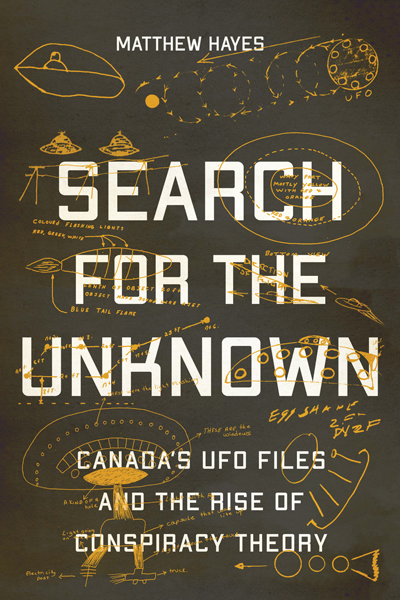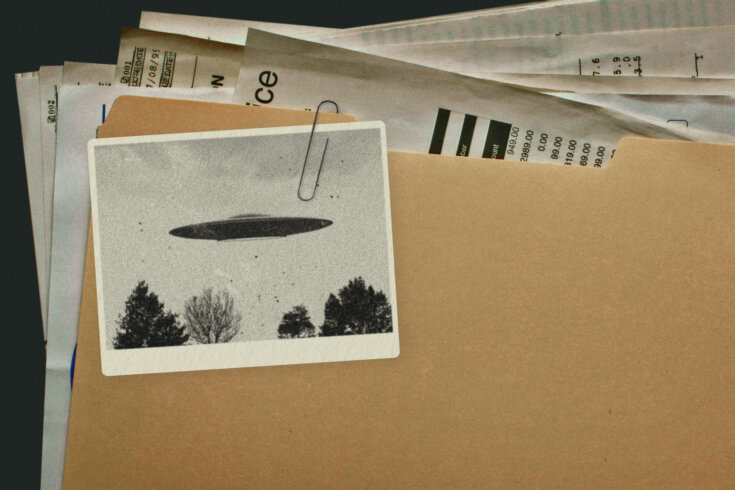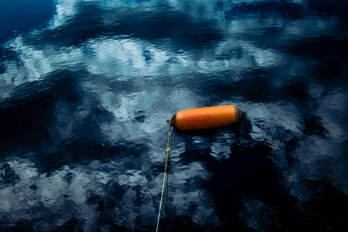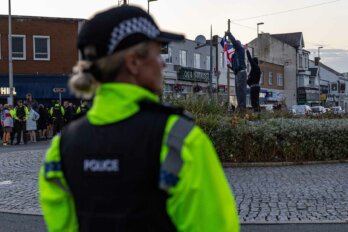 Adapted from Search for the Unknown: Canada’s UFO Files and the Rise of Conspiracy Theory by Matthew Hayes. Copyright © 2022 Matthew Hayes. Published by McGill-Queen’s University Press. Reproduced by arrangement with the publisher. All rights reserved.
Adapted from Search for the Unknown: Canada’s UFO Files and the Rise of Conspiracy Theory by Matthew Hayes. Copyright © 2022 Matthew Hayes. Published by McGill-Queen’s University Press. Reproduced by arrangement with the publisher. All rights reserved.In July 1960, Vancouver resident Ken Kaasen wrote a letter to the Defence Research Board, Canada’s postwar military science agency. “It is a fact that Canada and the United States are not in complete control of their skies . . . As bad as it sounds, North America, and many other countries, are wide open for inspection by these unknown flying objects. Can you honestly deny that?” Kaasen was referring to UFOs. He was convinced that they existed and that the government knew this but chose to cover it up and stay silent. Kaasen closed his letter with a prayer: “I only hope the UFOs prove to be harmless.”
The next month, a publicity officer responded to Kaasen, refuting his claim. “You may be interested to learn that the vast majority of reported sightings have been explained by known phenomena. The remainder have not supplied evidence that any threat to our country exists.” Kaasen wrote back that proof that UFOs were piloted by extraterrestrial beings would be forthcoming imminently, though he did not say where this proof would come from. The publicity officer did not respond, and so Kaasen moved on and began writing to other departments, hoping to find a sympathetic ear.
For two years, Kaasen pursued correspondence with various government departments about unidentified flying objects, seeking answers about their origins, their purpose, and their risk to Canadians. He even wrote directly to the minister of national defence. None of the replies that Kaasen received seemed to satisfy his curiosity or alleviate his concerns, and the government officials involved admitted internally that they did not know how to handle his letters.
Kaasen’s letters constitute but one of many exchanges between Canadian citizens and Canadian government officials on the subject of UFOs. Often, UFO enthusiasts were bold in their assertions and demands for government intervention. In response, government officials usually attempted to either ignore such appeals altogether or, when they did engage, to debunk claims of UFO sightings as nothing other than normal atmospheric phenomena. These exchanges could become heated and convoluted and could carry on for months or even years. Between 1950 and the 1990s, the departments of national defence and transport, the National Research Council, and the RCMP attempted to understand what UFO sightings were and whether they posed a security threat or presented an opportunity for scientific inquiry. When they determined by the mid-1950s that there was neither, the challenge became one of responding to claims of UFO sightings and quelling public anxieties.
Over the course of the next four decades, these government agencies received thousands of unique UFO sighting reports and accumulated more than 15,000 pages of related documentation. Most of these reports came from, or were initiated by, concerned citizens, such as Kaasen, who were not happy with the government’s assumption—which citizens gleaned from their correspondence with government officials—that UFOs posed no threat. These citizens wrote thousands of letters to the government, campaigning for the disclosure of information about UFOs. When they received what they thought were inadequate responses, they turned, in some cases, to conspiracy theories and otherwise tried to solve the mystery themselves by starting UFO clubs and citizen investigation groups.
Despite these efforts, the UFO phenomenon remains a mystery to Canadians. In 2005, Library and Archives Canada released a virtual exhibition titled Canada’s UFOs: The Search for the Unknown. This resource allows users to search a selection of UFO documents and offers a short timeline and map featuring some of the more sensational sightings. The exhibition was created as part of a broader initiative, begun in the late 1990s, which “utilised the interactive technology of the Web, making digitised images more than just illustrations or pictures at an exhibition.” The point was to make as many records as possible accessible to the public.
In the words of Michael Eamon, project manager for Canada’s UFOs, the initiative was meant “to make records known.” At LAC, during this wave of digitization, there was no special interest in the UFO material other than that the public generally found the subject intriguing—it was a “hot topic”—and so it lent itself well to a virtual presentation that might draw in more eyes. It certainly worked to draw me in. I stumbled across it one day while idly reading about UFOs. In fact, the site provided the inspiration for what eventually became my book, Search for the Unknown: Canada’s UFO Files and the Rise of Conspiracy Theory.
Released ten years after the NRC catalogued the final sighting as part of Canada’s UFO investigation, Canada’s UFOs covers the length of the whole project. LAC created the exhibition in the absence of any specific directive to do so or contact with any other department originally involved, such as the Department of National Defence or the RCMP. They created it simply because of a sustained public interest in UFOs. The same year that Canada’s UFOs was released, new Gallup results showed that 21 percent of Canadians believed that extraterrestrials have visited Earth at some point in the past. While this number represents a decline from the 1970s and ’80s, the fascination has yet to disappear.
Sightings of UFOs remain steady today, although citizen organizations now perform all the data collection and analysis. This small, disconnected group of citizens, which began writing to the government for answers in the early 1960s, still exists today and continues to ask the same questions. A recent edited collection of essays by leading ufologists notes that, some seventy-five years after the Kenneth Arnold sighting and the alleged Roswell crash, we arguably know no more than we did then: “The UFO field has produced thousands of dedicated researchers over the years, and reams of literature; but to what end? What can we claim to know conclusively today about the underlying nature of UFO phenomena that we didn’t know in the late-1940s?”
We do know one thing. Namely, that the UFO issue in Canada represents a failure on both sides: citizens unable to convince the state of the reality of flying saucers and extraterrestrials, and the state unable to convince its citizens the pursuit was utterly irrational.
To date, there has been very little writing on Canada’s involvement with the UFO phenomenon. Several books have explored aspects of the investigation, focusing on specific events or surveying sightings over the years, but no work has provided a systematic history of the investigation from start to finish. To get a sense of how Canada came to be involved with the UFO phenomenon at all, a brief history of the American investigation is necessary. As the historian Greg Eghigian has stated, America was the clear “vector” in the UFO story, and given Canada’s proximity to the US, there was bound to be some spillover. Canada’s UFO history is also simultaneously a history of increasing American influence over Canadian affairs, especially in the cultural and political domains.
The year 1947 was pivotal to the UFO phenomenon; it was the beginning of the “modern era of UFOs.” On 24 June 1947, a businessman and private pilot named Kenneth Arnold was flying over Washington state when he witnessed nine shiny discs flying in formation past Mount Rainier. According to Arnold, the discs moved like rocks skipping across water. Arnold’s sighting gave rise to the moniker “flying saucer,” which an anonymous Associated Press journalist coined in the days after Arnold reported his sighting. Several weeks later, a second event was reported: an alleged crash in the desert outside of Roswell, New Mexico. This event, perhaps the most infamous of the entire phenomenon, is largely responsible for many of the familiar images now associated with UFOs. The standard story is that a technologically advanced craft piloted by extraterrestrial beings malfunctioned and crashed in the desert, only to be found by a local rancher in the early hours of the morning. The US army soon arrived and cleared the scene completely, leaving no traces behind. The next day, an army press release announced that a flying disc had crashed and was recovered. However, this story was quickly retracted, and the army instead claimed that what was really recovered were the remains of a balloon that had crashed. This correction was confirmed decades later by an investigation that revealed the details of Project Mogul, a US operation that used balloons to test for nuclear explosions in the upper atmosphere.
The reason for these tests was, of course, the Cold War, which was in full swing by this point. The Cold War—that “competition of ideas” between America and the Soviet Union—impacted the UFO phenomenon in a significant way in its early days, during the 1950s and into the 1960s. Fear of advanced Soviet technology and invasion was, at first, the obvious explanation for UFOs, at least for military and government officials. Some citizens, too, were explicitly concerned about Soviet intrusions, as expressed in their letters to the government. Fears that the Soviets might invade remote northern Canada as a means of gaining access to the US certainly played a role in the initiation of Canada’s own investigations into UFOs. This is one example of the increasing influence of American concerns on Canadian policy.
Perhaps unexpectedly, however, and quite abruptly, the Cold War fades from the picture after the mid-1960s. By this point, the American and Canadian governments had concluded that UFOs were not connected to the Soviet Union and, in fact, no nation on the planet seemed capable of producing such physics-defying craft.
In the late 1940s, though, nobody knew quite what to think. Those with a conspiracist mindset pounced on the 1947 Roswell UFO crash story, accusing the US government of a cover-up. This idea has only grown in scope and imagination since and serves as a founding myth of the phenomenon. The contemporary “disclosure” movement is predicated on the idea that the US government is hiding the “truth” about Roswell, and associated crashes and sightings, and that one day this information will finally be revealed to the public. Part of what fuelled this long-standing interest were the investigations that the US government conducted. After Kenneth Arnold’s sighting, which gained significant press attention, UFO sightings began to pour in. Even smaller newspapers, such as the Charlottetown Guardian in Prince Edward Island, commented on how widespread the sightings had become: “Stories about the discs from many parts of Canada and the United States continued to swirl just as rapidly as the objects themselves.” While the American government presumed that UFOs were misidentified natural phenomena, the fear that they were a foreign intrusion, or a top-secret domestic project unknown even to the air force, forced the US government to take action.
Beginning in 1948, two projects—Project Sign and Project Grudge—were established to investigate the phenomenon. The projects came to very different conclusions about UFOs: the former concluded that extraterrestrials could be behind the sightings, whereas the latter concluded that all sightings were due to common, natural events. The difference between the two reports has certainly contributed to the idea that some kind of a cover-up was taking place.
To the public, it seemed that the air force had stopped investigating UFO reports altogether by the end of 1949. The air force no longer made any public pronouncements about the subject and did their best to curb their correspondence with civilians. The US government did not like the publicity the studies were attracting, and there was always the fear that someone would divulge legitimate secrets. It is clear from the air force’s actions that they simply wanted the problem to go away as quickly as possible. But behind closed doors, the US Air Force investigation continued, albeit at a much more minimal level. Project Blue Book, the new investigation launched in 1952, “became largely a public relations effort to convince the American people that UFOs were explainable in prosaic terms.”
In 1966, the air force commissioned Edward Condon, a physicist at the University of Colorado, to assemble a team of scientists who would analyze the sighting reports that Project Blue Book had compiled. The result was the Condon Report, issued in January 1969, which concluded that the previous twenty-one years of UFO studies had yielded nothing of scientific value and that all efforts in the matter should be discontinued. It also reiterated the official stance that all sightings had mundane origins and that any unexplained cases were simply lacking information. On the report’s recommendation, the air force terminated Project Blue Book, ending the US government’s investigations, at least for the time being.
Canada’s own UFO investigation declined rapidly after 1980. The Department of National Defence managed to transfer responsibility for the investigation to an unwilling National Research Council, which in turn took a passive approach to the subject. The government’s position on the unreality of UFOs remained unchanged. If anything, the state’s attitude only hardened over time in response to citizens’ letters, and by the time the NRC catalogued its final UFO sighting in 1995, the agency had long given up any pretence at a serious investigation.
There is no single Canadian UFO archive. The thousands of pages of documentation that I used for my book are drawn from multiple governmental archives and collections—and were mostly located with a keyword search. They come from the files of the Department of National Defence, the Department of Transport, the Department of Communications, the RCMP, and the National Research Council. Rarely did departments communicate or collaborate with one another on UFO investigations, and so the documents usually remained with the originating department. This reluctance to communicate interdepartmentally became especially obvious when citizens began writing to various departments demanding answers to their questions and receiving different stock responses that were sometimes contradictory.
The vast majority of the documents are UFO sighting reports, either formal reports written by government officials or handwritten or typed letters that citizens sent to the government. A number of newspaper clippings of UFO stories are found throughout the various files, along with the occasional document from the US government. There are also letters, distinct from the sighting reports, that citizens wrote to various departments. Nearly all sighting reports originated with a citizen who informed authorities—for instance, the local RCMP detachment. From there, the RCMP investigator or government official would type up and file the report with their department. However, many of the letters that citizens sent in were much more than just a report of an observation. They often contained detailed speculations about the origins of the UFOs and asked many questions of the government about its understanding of the phenomena. There are inevitably some letters from citizens who, convinced that the Canadian government was covering up the truth, demanded some kind of disclosure.
The bulk of the documents were conventional sighting reports. These were often RCMP reports, although some originated through other bodies such as the Department of National Defence and, in some cases, air traffic control centres. In total, I counted nearly 4,500 unique UFO sightings in Canada from 1949 to 1995. Most sightings came from Ontario, Alberta, Quebec, and British Columbia. There was a very large spike in sightings in 1967. Sighting reports slowly increased over the years, reaching their highest point in 1969, with 283 sightings. The 1970s was the decade with the most sightings; these were distributed approximately 75 percent rurally and 25 percent in urban centres. This is easily explained by such simple factors as the level of light pollution in urban centres, which made it difficult to make out aerial or celestial objects. The overall increase in sighting reports over time reflects several factors: a growing awareness among the public about UFOs, a willingness to report sightings, and the standardization of reporting mechanisms within the government.
While 4,500 sounds like an impressive number of sightings, spread over forty-five years, it amounted to an average of one or two sightings per week nationwide. In some weeks, there were several sightings, with none being reported in other weeks. Considered from this angle, it is perhaps unsurprising that the media paid little attention. From 1947 until 1995, only about a dozen articles on the topic were published in national newspapers or magazines. Local newspapers, especially in rural areas, published about UFOs more regularly, however. And since they were usually reporting on local sightings by people known within the community, they tended to take a less skeptical position and described in detail what had been told to them. In my book, I highlight this difference in media reporting by including local articles that countered the “official” or national view.
In addition, I explored the impact of other kinds of media—namely, films, TV series, and books—that played a pivotal role in disseminating information about UFOs to the public. The role of American pop culture and entertainment in the UFO phenomenon was significant, certainly helping to drive up sightings over the years. Newspaper reports served to highlight the many sightings reported from around the country, but it was the films of Hollywood, along with television shows and books, predominantly from American producers, that helped solidify the UFO and extraterrestrial tropes with which we are now familiar. These included, notably, the alien abduction theme and even the physical look of the typical almond-eyed extraterrestrial, made famous by the cover of Communion, Whitley Strieber’s bestselling account of alien abduction.
Overall, the UFO reports registered as a persistent low-level hum, a phenomenon constantly in the background of the activities of the RCMP, National Research Council, and Department of National Defence, among other departments. My history of UFO investigations focuses mostly on the peak periods of activity—on both the government side and the citizen side. Yet it is important to keep in mind that throughout this nearly fifty-year period, there was a continuous flow of sightings all across the country.
Encounters that left behind physical traces were the one kind that attracted the government’s attention. There were three cases from 1967 that defied explanation: Stefan Michalak’s UFO encounter at Falcon Lake, Manitoba; the crop circles in a farmer’s field at Duhamel, Alberta; and the Shag Harbour crash in Nova Scotia. Each of these three cases provided material that government scientists could actually analyze. Unfortunately, even these exceptional cases failed to convince government officials of the reality of UFOs. Each investigation simply hit a wall, as the evidence failed to yield further clues. Although these cases remain mysteries, they also represent the climax of the Canadian government’s investigation into UFOs.
There were several individuals in the Canadian government, however, who did take UFOs seriously. Wilbert Smith, an electrical and radio engineer employed at the Department of Transport, became convinced that UFOs were real, the product of extraterrestrial intelligence. He set about trying to prove this through a series of experiments, conducted between 1950 and 1954 under the banner of Project Magnet at the Department of Transport. His efforts included establishing “weighting factors” to assist in determining the validity of any given UFO observation, a balloon experiment which he conducted in an attempt to ascertain the reliability of witness observations, and the establishment of a UFO observatory on the outskirts of Ottawa. His efforts were largely unsuccessful, as he failed to convince his colleagues. The department terminated Project Magnet in 1954, forcing Smith to continue his work privately.
For scientists like Peter Millman, the NRC astronomer who chaired Project Second Storey, one of Canada’s two UFO investigations which ran from 1952 to 1954, UFOs never even registered as genuinely real. If they were real at all, they existed for Millman only as misidentified natural phenomena. What the UFO mystery came down to was the problem of stubbornness on the part of citizens and the need for the state to educate the public. This was the philosophy behind the approach of the PSS committee. PSS concluded that UFOs neither posed a security threat nor were of scientific interest. More specifically, UFOs were simply not amenable to scientific inquiry—that is, they did not even constitute a type of object that scientists could, or would, study. As such, the committee recommended ending all such investigations and ensuring thereby that any citizens asking for information would be told in no uncertain terms that UFOs were a waste of time. PSS’s conclusion had a significant impact on the study of UFOs in Canada for decades to come.
At the heart of this story are the myriad changes taking place during Canada’s postwar years. The horrors of the world wars shook public confidence in technical expertise and the state’s ability to ensure the safety and well-being of its citizenry. It became common to hear Canadians express distrust of their government and even opposition to its authority. Ian Milligan argues that “a new culture of defiant anti-authoritarianism and self-expression” animated youth during the 1960s. Neil Nevitte, writing about the 1980s specifically, has called this change a “decline of deference.” As the UFO documents showed, however, this shift began decades earlier. A small, scattered group of citizens made it clear in their letters that they were not afraid to call out the government when they felt they had discovered duplicity in its UFO investigation, however bizarre their approach may have seemed. The government, for its part, found itself unprepared to handle this new kind of interaction and unwilling to engage with the antagonistic approach on which some citizens insisted.
It was not simply the case that the government and citizens held different views on the matter. The back and forth was more dynamic, with each side’s attempts to convince the other simply reinforcing already entrenched views. Joseph Uscinski describes this situation as a battle of ideas: “It isn’t just that conspiracy theorists have a different set of explanations, it is that their explanations call into question our knowledge-generating and knowledge-disseminating institutions.”
What I learned while working on Search for the Unknown was that both the state and its citizens used UFOs in specific ways and toward certain ends. For the state, the UFO investigations were an opportunity to convince Canadians of the value of scientific knowledge and expertise; in so doing, the state enhanced its own authority as the arbiter of such expertise. For citizens, the UFO phenomenon inspired them to mobilize and demand greater transparency from a state that appeared inaccessible and even untrustworthy. The irony that UFO enthusiasts appear to have missed is that, in some ways, the alien force earthlings have been arrayed against is their own government.





